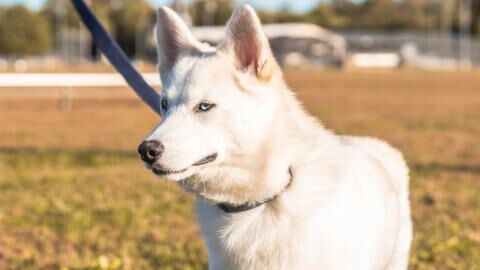No one knows why Snowy has not been adopted yet, but everyone has hope, including her. Snowy is a Staffordshire bull terrier who has spent 500 days in kennels at the RSPCA’s Birmingham Animal Centre.
Discover our latest podcast
https://www.rspca.org.uk/local/birmingham-animal-centre/findapet/details/SNOWY/216050/rehome
Posted by RSPCA Birmingham Animal Centre and Hospital on Thursday, February 17, 2022
Find a home
Snowy’s previous owners let her off lead in built-up areas, as such, she has had several altercations with local dogs. During her time at the RSPCA centre, she has been trained and passed her behaviour checks. However, she still needs to wear a muzzle and be on a lead all the time in public.
The staff at the animal centre confirms she is a super sweet girl who loves her fuss and has a lot of energy. She would like owners who would take her out on long walks and play with her as she loves her playtime.
The animal centre has been struggling to find a suitable match for her and issued a desperate plea to increase her chances. The ideal owner should be dog-savvy and can help her with her anxiety around other dogs. As such, she would prefer a house with no other pets. And although Snowy has gone through her fair share of training at the animal centre, she still may need a little more once she finds the right owners.
Read More
⋙ This ‘most overlooked’ dog is still hoping to find a forever home after 900 days of ignorance
⋙ These owners abandoned their dog for this unusual reason
⋙ Depression: How to tell if your dog is depressed and how you can help
Dogs with anxiety
The thing with human anxiety is that people can actually communicate that they are feeling anxious, however, dogs do not. Not so much in words at least. Their body language is the best indicator that will let you know that your dog has anxiety. Here are a few signs you need to look after:
- Unusual reactions in unfamiliar locations
- Panting or pacing
- Shaking or trembling
- Whining
- Barking
- Tail tucked in or ears back
- Unnecessary aggression
- Escaping situations and people

Every dog is different and will show its anxious state differently. Look out for such signs in them and notice if they are a one-time thing or typical behaviour. Some dogs might do it out of boredom or irritation, however, if they constantly act that way it is trouble. If your dog is showing signs of anxiety, you can help them in the following ways:
Treats/toys
Give your dog something that they can lick. Licking is a calming activity for them and will help them ease their minds.
Distraction
If they do not respond well to your treats or toys, distract them with trained commands. Ask them to sit/stand/walk/lie down and all such commands that they know.
Safe space
Create a safe space for them (just like a panic room), where they can go and relax. Keep the environment familiar by using the same sheets, pillows or mats.















